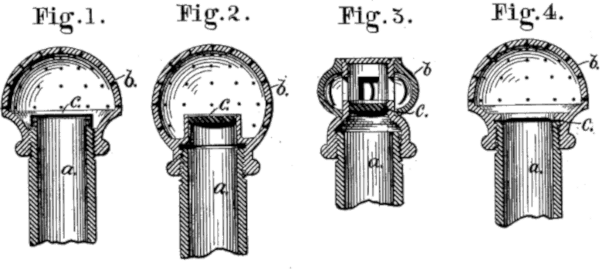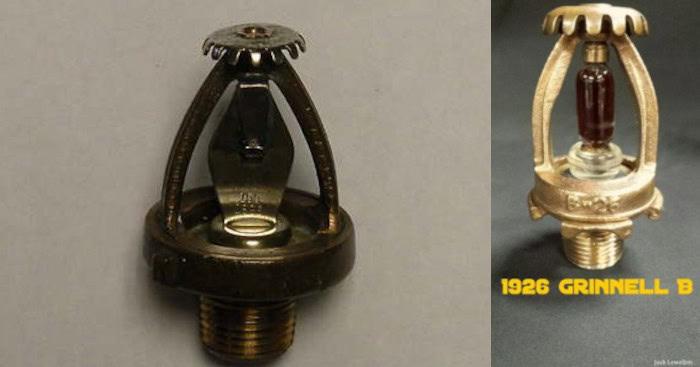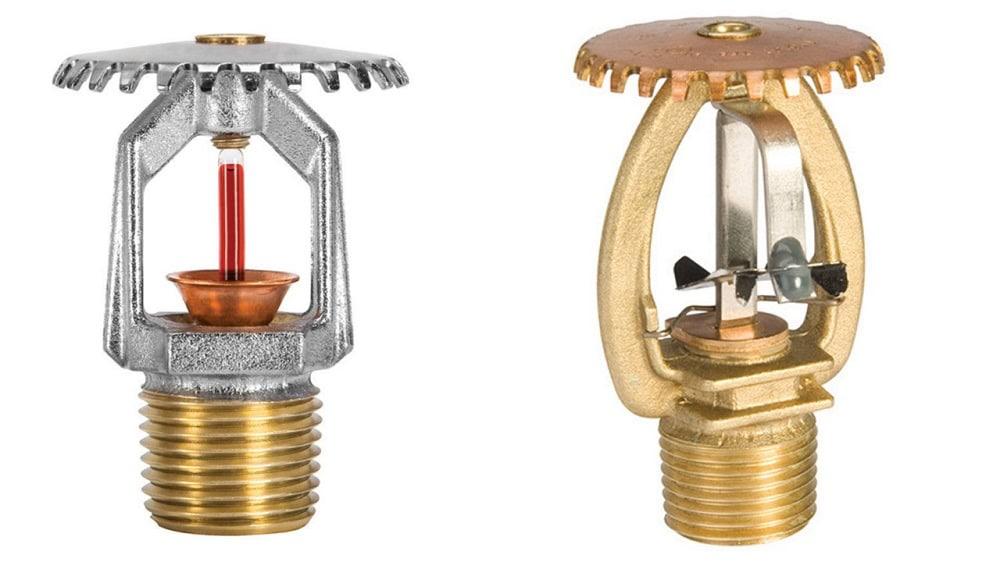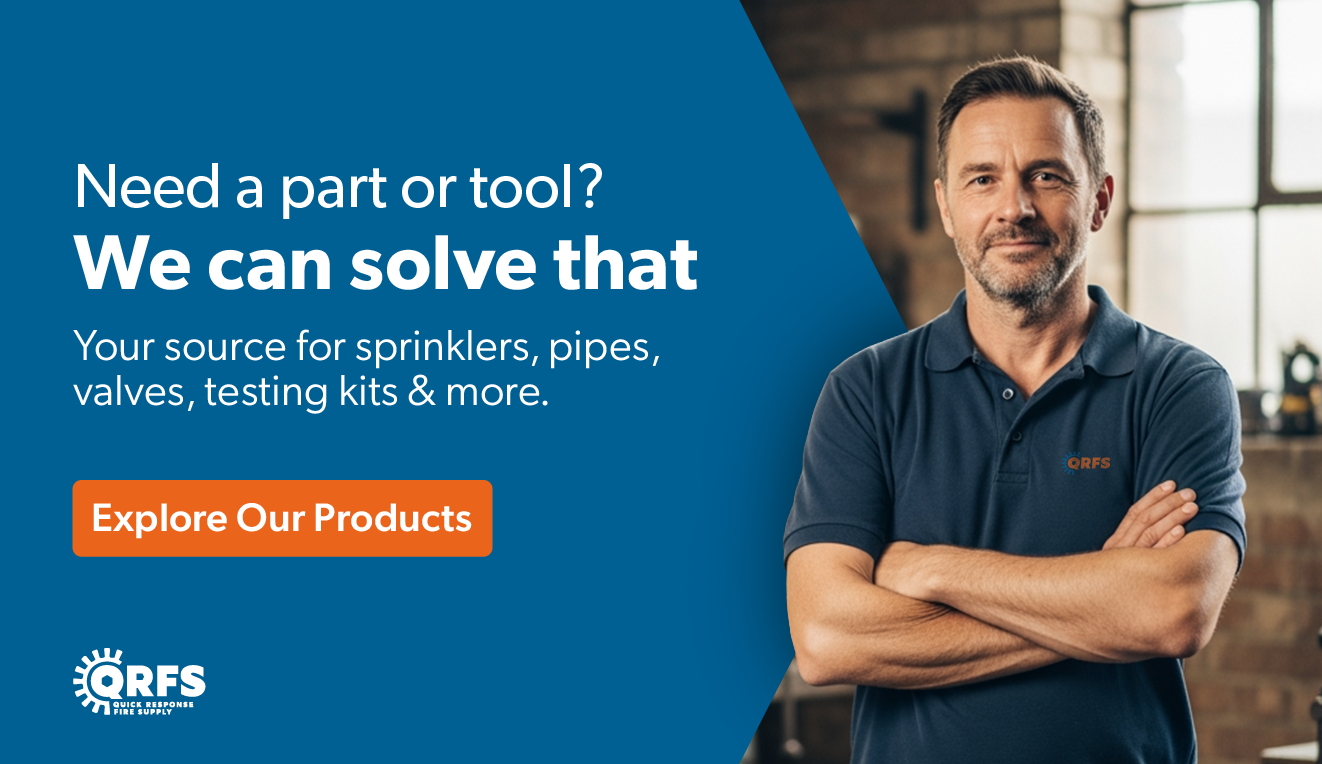The practical differences are minimal, so why choose one if there’s a choice?
The vast majority of automatic fire sprinklers have heat-sensitive elements that mechanically break when the temperature rises during a fire to release water. They come in two kinds: fusible link sprinkler heads and glass bulb sprinklers.
A link sprinkler has small metal pieces joined (fused) by a solder to hold a sprinkler’s pip cap in place. When a fire melts the solder, the link falls away, the cap releases, and water flows. Bulb sprinklers use a similar principle but rely on a glass bulb filled with a heat-sensitive liquid. When the liquid expands due to heat, the bulb bursts, releasing the parts and allowing the water to spray.
Although fusible link sprinklers are the original type, glass bulb sprinklers currently dominate the market. However, manufacturers often offer link and bulb versions of their major sprinkler models—for example, Tyco’s TY-B and TY-L lines (“B” is for bulb, “L” is for link).
So, what’s the difference? In short, there are no major differences. Both sprinkler types perform similarly. However, there are some uncommon but practical reasons system owners choose one over the other.
Read on to learn about:
- A brief history of link and bulb sprinklers
- Why bulb sprinklers are currently more popular
- Differences in activation temperatures
- The use of link sprinklers in food manufacturing
QRFS is your source for sprinkler heads from Viking, Victaulic, Reliable, Tyco, and Senju—plus the cover plates, escutcheons, and tools you need!
Fusible-link sprinkler heads are the OG, and bulb sprinklers are the innovation
The world’s first fire sprinkler system is believed to have been deployed by none other than Leonardo Da Vinci. However, his system seems to have been manually triggered. History’s first attempt at automatic sprinklers was made by Ambrose Godfrey of England in 1723. His device relied on fuses that triggered a gunpowder charge that would release the water. Godfrey also takes the laurels for the first fire extinguisher. This design naturally also involved gunpowder—a sort of anti-fire grenade.
The first sprinkler that resembles its modern form appeared in 1872, patented by American Philip Pratt. Henry S. Parmelee, another American, improved upon Pratt’s design and patented what is considered the first practical automatic sprinkler system in 1874. The Parmalee sprinkler used a fusible metal link with a solder that melted to activate the water flow.

Parmelee’s sprinkler was manufactured by Providence Steam and Gas Pipe Co., whose president was Frederick Grinnell. Grinnell modified and improved Parmelee’s design, obtaining his own patent in 1881. Grinnell’s design featured a more sensitive soldered element and a sprinkler deflector. With this invention, Grinnell essentially launched the fire sprinkler industry as we know it today. The first glass-bulb sprinkler appeared in 1920 from Grinnell’s company.

Today, the glass bulb sprinkler is preferred
QRFS spoke to Kenneth Isman, MS, PE, one of the leading experts on all things fire sprinkler, to help us understand the difference between glass bulb and fusible link sprinkler heads. We also spoke to technical representatives from Tyco—the company that now owns the Grinnell brand.
In general, these two types of sprinklers have no major performance differences. However, there are three reasons bulbs are more common when there is a choice: price, appearance, and durability. In addition, choosing a bulb or link sprinkler often depends on maintaining consistency with what a system has.
Bulb sprinklers are easier and cheaper to manufacture
Glass-bulb sprinklers are easier to assemble than soldered-link sprinklers. This makes mass production more efficient and (in theory) makes bulb sprinklers less expensive. In practice, however, increased demand for these sprinklers balances out efficient production, making bulb and link sprinklers approximately equal in price. Some of that increased demand comes from how bulb sprinklers look.
Architects like the appearance
Not every fire protection decision is purely functional. Sometimes, things need to look nice. Isman explained that architects often specify bulb sprinklers simply because they like how they look on the ceiling. Soldered link sprinklers give off more of an industrial vibe that not everyone wants.
Durability: The solder might run without activating
Tyco’s representatives mentioned that glass bulb sprinklers are seen as more durable when exposed to heat than fusible link sprinkler heads. The reasoning is this: if you heat up a glass bulb sprinkler without reaching its activation temperature, the heat-sensitive element always returns to normal. But if you heat a link sprinkler near that threshold, the solder could “run” a bit without triggering an activation, and the sprinkler might not be ‘like-new’ afterward.
Obviously, link sprinklers still achieve the same listings and approvals as bulb sprinklers, so it’s unclear how big of an issue this is in practice. They are tested to perform as advertised, and the multi-year (often multi-decade) testing intervals to see if sprinklers must be replaced don’t depend on the activation mechanism.
Link vs. bulb: replacing what you have
When replacing fire sprinklers (such as after they fail an inspection or a test), the authority having jurisdiction (AHJ) may require using the same type of sprinkler that was originally installed. So, a system owner just replaces a bulb sprinkler with a bulb sprinkler or a link sprinkler with a link sprinkler—even if two bulb and link sprinklers otherwise have the same specs.
Fusible link sprinkler heads have fewer (and different) temperature options
Look closely at sprinkler data sheets, and you’ll spot a small difference between link and bulb sprinklers: their activation temperatures. As a rule, bulb sprinklers have more temperature options than link sprinklers.
Fusible link heads also generally don’t come in precisely the same activation temperatures as bulb sprinklers, even though they still fall within the same ranges of NFPA 13’s temperature ratings and “ordinary,” “intermediate,” “high,” etc. temperature classifications.
Below, we’ve compiled activation temperatures for some link and bulb quick-response pendent sprinklers from Tyco, Viking, and Reliable sprinklers, focusing on 5.6K models. (We looked at older-model Microfast sprinklers for Viking because the company’s current XT-1 models don’t use the link mechanism.)

Fusible link sprinklers are preferred in food processing
There is one application where link sprinklers are often preferred or required over bulb sprinklers: food processing and service. For example, American and European regulations require food manufacturers to ensure their products are free of physical adulterations such as broken glass. These rules can mean taking concerted steps to eliminate the presence of any breakable glass on the cooking, serving, or production line, including using glass-bulb fire sprinklers.
Neither the US Food and Drug Administration (FDA) Food Code (2022 edition) nor Title 21 of the US Code of Federal Regulations (the FDA’s section) specifically mention fire sprinklers in this context. However, they contain general mandates to take steps to minimize breakable glass in and around (and especially above) food production lines. In addition, local codes and insurance requirements, along with best practices, may specify link sprinklers.
Thus, manufacturers such as Viking and Tyco specifically market some link sprinklers for food-processing environments because they are glass-free. Isman and Tyco representatives also discussed working with clients/customers who specifically requested link sprinklers to avoid the presence of glass on the manufacturing floor due to local codes or internal company rules.
For most purposes, link and bulb sprinklers are nearly interchangeable
Fusible link sprinklers rely on melting solder to activate water flow, while bulb sprinklers use expanding liquid to break a glass bulb. While these two mechanisms look quite different, they both achieve the same effect. They put the “automatic” in automatic fire sprinklers, and both bulb and link sprinklers from major manufacturers are listed to ensure reliability and performance.
Most sprinkler manufacturers offer link and bulb versions of similar sprinklers. However, unless someone needs to minimize the potential for broken glass in a food serving, production, or processing environment or another setting, most people choose glass bulb models.
For your fire sprinkler needs, turn to QRFS. We have sprinklers from Viking, Victaulic, Reliable, Tyco, and Senju, plus compatible cover plates, escutcheons, wrenches, and other tools.
Our main catalog currently focuses on bulb sprinklers, though we continually expand our inventory. If you need a sprinkler you don’t see online, contact our customer service team at 888.361.6662 or support@qrfs.com to place a special order.
This blog was originally posted at blog.qrfs.com. If this article helped you, check us out at Facebook.com/QuickResponseFireSupply or on Twitter @QuickResponseFS.



